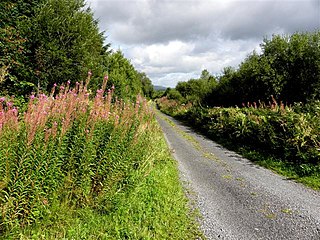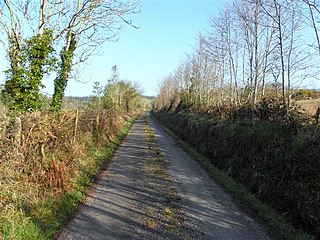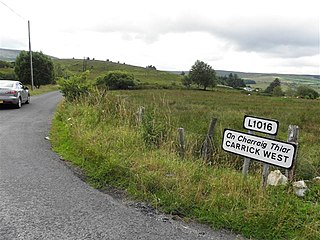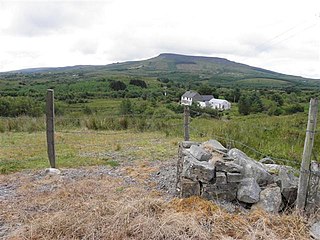Related Research Articles

Drumlougher is a townland in the civil parish of Templeport, County Cavan, Ireland. It lies in the Roman Catholic parish of Templeport and barony of Tullyhaw.

Killycrin is a townland in the civil parish of Templeport, County Cavan, Ireland. It lies in the Roman Catholic parish of Templeport and barony of Tullyhaw.

Killywaum is a townland in the civil parish of Templeport, County Cavan, Ireland. It lies in the Roman Catholic parish of Templeport and barony of Tullyhaw.

Derrynacreeve is a townland in the civil parish of Templeport, County Cavan, Ireland. It lies in the Roman Catholic parish of Corlough and barony of Tullyhaw.
Derrynaslieve is a townland in the civil parish of Templeport, County Cavan, Ireland. It lies in the Roman Catholic parish of Corlough and barony of Tullyhaw.
Leitra is a townland in the civil parish of Templeport, County Cavan, Ireland. It lies in the Roman Catholic parish of Corlough and barony of Tullyhaw.
Garvary is a townland in the civil parish of Templeport, County Cavan, Ireland. It lies in the Roman Catholic parish of Corlough and barony of Tullyhaw.

Carrick West,, is a townland in the civil parish of Templeport, County Cavan, Ireland. It is named Carrick West or Carrick Hassard to distinguish it from Carrick East or Carrick Fisher townland which is in Templeport parish. It lies in the Roman Catholic parish of Glangevlin and barony of Tullyhaw.

Coppanaghbane, an Anglicisation of the Gaelic ‘Copanach Bán’ meaning The White Place covered with Dock-leaves, is a townland in the civil parish of Templeport, County Cavan, Ireland. It lies in the Roman Catholic parish of Glangevlin and barony of Tullyhaw.
Coppanaghmore, an Anglicisation of the Gaelic ‘Copanach Mór’ meaning The Big Place covered with Dock-leaves, is a townland in the civil parish of Templeport, County Cavan, Ireland. It lies in the Roman Catholic parish of Glangevlin and barony of Tullyhaw.

Curraghglass, an Anglicisation of the Gaelic, ‘Currach Glas’ meaning The Green Moor, is a townland in the civil parish of Templeport, County Cavan, Ireland. It lies in the Roman Catholic parish of Glangevlin and barony of Tullyhaw.

Curraghvah, an Anglicisation of the Gaelic, either ‘Currach Bheathach’, meaning The Moor of the Birches, or ‘Currach a’ Mhagh’, meaning The Moor of the Plain, or ‘Currach Mheádh’ meaning The Moor of the Spicy Mead Drink, is a townland in the civil parish of Templeport, County Cavan, Ireland. It lies in the Roman Catholic parish of Glangevlin and barony of Tullyhaw.

Derrylahan, an Anglicisation of the Gaelic, ‘Doire Leathan’ meaning The Wide Oak-wood, is a townland in the civil parish of Templeport, County Cavan, Ireland. It lies in the Roman Catholic parish of Glangevlin and barony of Tullyhaw.

Derrynananta Lower, an Anglicisation of the Gaelic, ‘Doire na Neannta Íochtar’, meaning The Lower Oak-wood of the Nettles, is a townland in the civil parish of Templeport, County Cavan, Ireland. It lies in the Roman Catholic parish of Glangevlin and barony of Tullyhaw.

Derrynatuan, an Anglicisation of the Gaelic, either ‘Doirín an tSuain’, meaning The Little Oak-wood of the Rest or Sleep, or ‘Doire na Tóin’, meaning The Oak-wood of the Low Lying Land, or ‘Doire na Tamhan’, meaning The Oak-wood of the Tree-Stumps, is a townland in the civil parish of Templeport, County Cavan, Ireland. It lies in the Roman Catholic parish of Glangevlin and barony of Tullyhaw.

Drumhurrin, an Anglicisation of the Gaelic ‘Droim Shoirn’, meaning The Hill-Ridge of the Lime-Kiln or Furnace, is a townland in the civil parish of Templeport, County Cavan, Ireland. It lies in the Roman Catholic parish of Glangevlin and barony of Tullyhaw.
Knockgorm, an Anglicisation of the Gaelic 'Cnoc Gorm', meaning The Blue Hill, is a townland in the civil parish of Templeport, County Cavan, Ireland. It lies in the Roman Catholic parish of Glangevlin and barony of Tullyhaw.
Legnagrow, an Anglicisation of the Gaelic, either Lag na gCnó 'The Hollow of the Nuts', or Lag na gCro 'The Hollow of the Huts or Sheep-Folds', is a townland in the civil parish of Templeport, County Cavan, Ireland. It lies in the Roman Catholic parish of Glangevlin and barony of Tullyhaw.
Mullaghlea Glen, is a townland in the civil parish of Templeport, County Cavan, Ireland. It lies in the Roman Catholic parish of Glangevlin and barony of Tullyhaw.
Mully Lower, an Anglicisation of the Gaelic, ‘Mullach Íochtar’ meaning The Lower Summit of the Hill, is a townland in the civil parish of Templeport, County Cavan, Ireland. It lies in the Roman Catholic parish of Glangevlin and barony of Tullyhaw.
References
- ↑ "Placenames Database of Ireland" . Retrieved 29 February 2012.
- ↑ "IreAtlas" . Retrieved 29 February 2012.
- ↑ "Memorial extract — Registry of Deeds Index Project".
- ↑ "Memorial extract — Registry of Deeds Index Project".
- ↑ "A list of the Several Baronies an Parishes in the County of Cavan" (PDF). Archived from the original (PDF) on 6 April 2016.
- ↑ http://titheapplotmentbooks.nationalarchives.ie/search/tab/results.jsp?surname=&firstname=&county=Cavan&townland=Golagh+in+Glan&parish=Templeport&search=Search&sort=&pageSize=&pager.offset=0 Tithe Applotment Books 1826
- ↑ http://census.nationalarchives.ie/reels/vob/IRE_CENSUS_1821-51_007246947_00143.pdf [ bare URL PDF ]
- ↑ http://census.nationalarchives.ie/reels/vob/IRE_CENSUS_1821-51_007246947_00144.pdf [ bare URL PDF ]
- ↑ http://census.nationalarchives.ie/reels/vob/IRE_CENSUS_1821-51_007246947_00145.pdf [ bare URL PDF ]
- ↑ http://www.askaboutireland.ie/griffith-valuation/index.xml?action=doNameSearch&PlaceID=221133&county=Cavan&barony=Tullyhaw&parish=Templeport&townland=%3Cb%3EGowlat%3C/b%3E - Griffith's Valuation
- ↑ "03/04/1863 the Police Gazette, or Hue-And-Cry | Rare Newspaper on Last Chance to Read".
- ↑ "Corrabha (Curravagh) | the Schools' Collection".
- ↑ "Corrabha (Curravagh) | the Schools' Collection".
- ↑ http://www.census.nationalarchives.ie/pages/1901/Cavan/Derrylahan/Gowlat/ Census of Ireland 1901
- ↑ http://www.census.nationalarchives.ie/pages/1911/Cavan/Derrylahan/Gowlat/ Census of Ireland 1911
- ↑ "Bawnboy and Templeport History Heritage and Folklore - Past and Present".
- ↑ "Commissioners of National Education in Ireland : Fifty-third report, 1886, with appendices". 1887.
- ↑ "Enhanced British Parliamentary Papers on Ireland".
- ↑ "ArcGIS Web Application".
